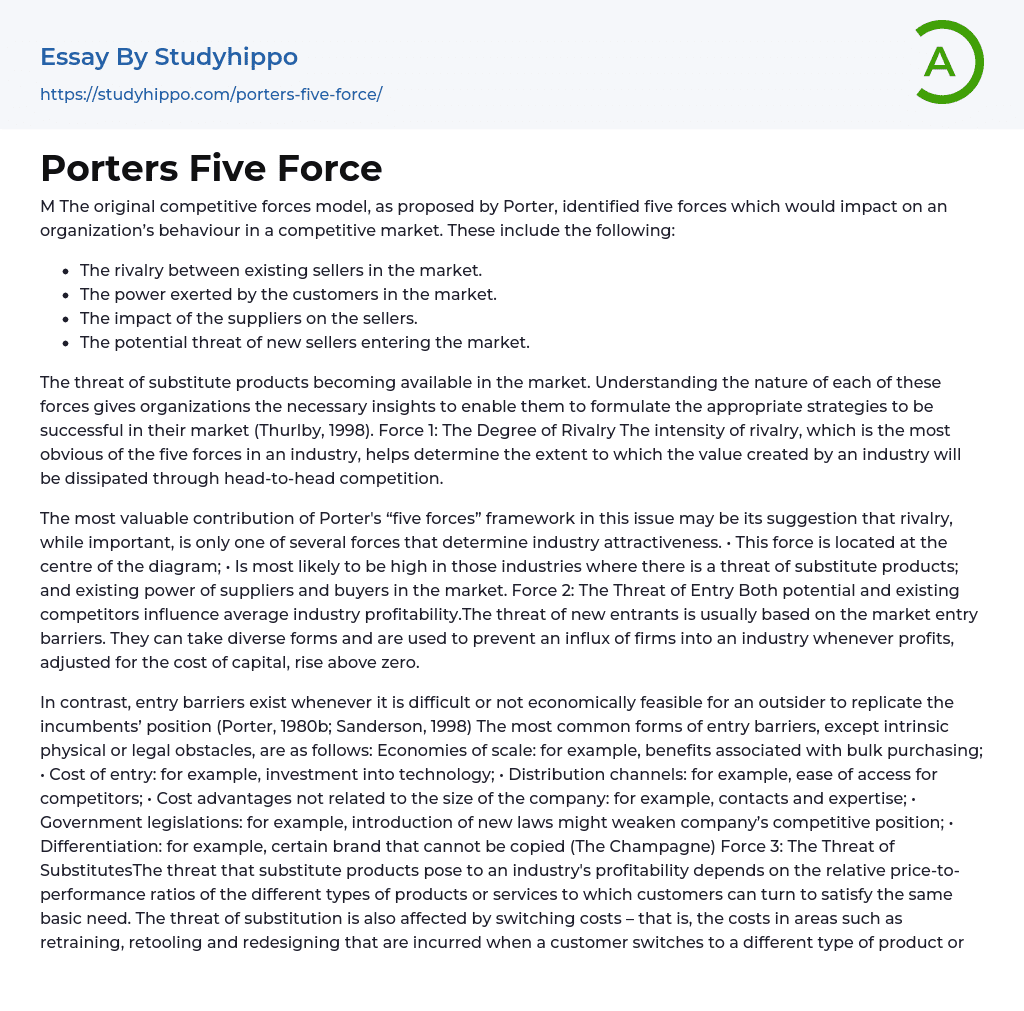The original model by Porter identified five forces that would affect an organization's behavior in a competitive market. These forces include the rivalry among existing sellers, the power of customers, the influence of suppliers, the potential threat of new sellers, and the chance of substitute products emerging.
In order for organizations to formulate successful strategies in their market, it is important to understand the nature of each of the forces discussed (Thurlby, 1998). One of the key forces is the degree of rivalry within the industry, which determines how much value is lost through direct competition. Porter's framework suggests that while rivalry is important, there are other forces at play as well. It is located at the center of the diagram and tends to be higher in industries with a threat of substitute products, as well as strong power from suppliers and buyers.
Another important force
...is the threat of entry, which both potential and existing competitors impact. This threat is based on the barriers to entering the market, which can take different forms and are used to prevent excessive competition whenever profitability exceeds the cost of capital.
In contrast, entry barriers exist when it is challenging or not financially feasible for an outsider to replicate the incumbents' position (Porter, 1980b; Sanderson, 1998).
The most common forms of entry barriers, excluding inherent physical or legal obstacles, include the following:
- Economies of scale: such as the benefits associated with bulk purchasing;
- Cost of entry: for instance, investment into technology;
- Distribution channels: like the ease of access for competitors;
- Cost advantages unrelated to company size: such as contacts and expertise;
- Government legislations: such as the introduction of new laws that ma
weaken a company's competitive position;
- Differentiation: such as a unique brand that cannot be copied (e.g., The Champagne).
Force 3: The Threat of Substitutes
The profitability of an industry can be influenced by the threat of substitute products, which depends on the relative price-to-performance ratios of different types of products or services that customers can use to satisfy the same basic need. The threat of substitution is also influenced by switching costs, which refer to the costs incurred when a customer switches to a different product or service that require retraining, retooling, and redesigning.
Additionally, it involves:
- Product-for-product substitution (e.g., email for mail, fax) based on the substitution of need;
- Generic substitution (e.g., video suppliers competing with travel companies).• The substitution of items that people can go without, such as cigarettes and alcohol, is a strong force known as Buyer Power. This force is one of the horizontal forces that affect how an industry distributes the value it creates (refer to the diagram). The size and concentration of customers are significant factors in determining buyer power. Other factors include the level of buyer knowledge and the concentration or differentiation of competitors. Kippenberger (1998) suggests that it is helpful to differentiate between potential buyer power and the willingness or motivation of buyers to exercise that power. This willingness is often influenced by the perceived risks associated with using a particular product.
There are several factors that determine supplier power in a market. It tends to be high when there are only a few dominant players, such as in the case of retailers and grocery stores. It is also high when there are many small suppliers who offer similar products, like
small farming businesses supplying large grocery companies. Additionally, when switching between suppliers is easy and cost-effective, supplier power tends to be low, as seen in the example of switching fleet suppliers for trucks.
Supplier power is the opposite of buyer power and is influenced by the size and concentration of suppliers in comparison to industry participants, as well as the level of differentiation in the inputs they provide. If suppliers have the ability to charge different prices based on the value created for each buyer, it suggests a market with high supplier power and low buyer power.
The bargaining power of suppliers can be observed in various situations: when switching costs are high (such as switching internet providers), when brands have significant power (for example, McDonald's, British Airways, Tesco), when suppliers have the option to integrate forward (like brewers buying bars), and when customers are dispersed and have limited bargaining power (for instance, gas/petrol stations in remote areas).
- Chief Executive Officer essays
- Convenience Store essays
- Firm essays
- Training And Development essays
- Unilever essays
- Variable Cost essays
- Virgin Group essays
- Bargaining essays
- Entity essays
- Pest analysis essays
- John Locke essays
- 9/11 essays
- A Good Teacher essays
- A Healthy Diet essays
- A Modest Proposal essays
- A&P essays
- Academic Achievement essays
- Achievement essays
- Achieving goals essays
- Admission essays
- Advantages And Disadvantages Of Internet essays
- Alcoholic drinks essays
- Ammonia essays
- Analytical essays
- Ancient Olympic Games essays
- APA essays
- Arabian Peninsula essays
- Argument essays
- Argumentative essays
- Art essays
- Atlantic Ocean essays
- Auto-ethnography essays
- Autobiography essays
- Ballad essays
- Batman essays
- Binge Eating essays
- Black Power Movement essays
- Blogger essays
- Body Mass Index essays
- Book I Want a Wife essays
- Boycott essays
- Breastfeeding essays
- Bulimia Nervosa essays
- Business essays
- Business Process essays
- Canterbury essays
- Carbonate essays
- Catalina de Erauso essays
- Cause and Effect essays
- Cesar Chavez essays




